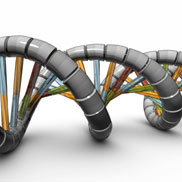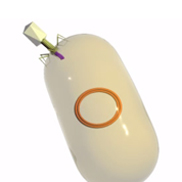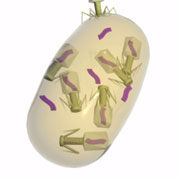
The chemical nature and structure of DNA were not elucidated until the middle of the twentieth century. Prior to that point, scientists had spent years speculating about which of the many types of molecules within cells contained the hereditary information. Was it protein? Was it something else — perhaps even a molecule they had yet to discover? Eventually, researchers zeroed in on DNA as the substance responsible for the transfer of traits from one generation to the next. From there, the race was on to learn more about this remarkable molecule.
Who first identified DNA?
Although James Watson and Francis Crick determined the double-helical structure of DNA, DNA itself was identified nearly 90 years earlier by Swiss chemist Friedrich Miescher. While studying white blood cells, Miescher isolated a previously unknown type of molecule that was slightly acidic and contained a high percentage of phosphorus. Miescher named this molecule "nuclein," which was later changed to "nucleic acid" and eventually to "deoxyribonucleic acid," or DNA. Interestingly, Miescher did not believe that nuclein was the carrier of hereditary information, because he thought it lacked the variability necessary to account for the incredible diversity among organisms. Rather, like most scientists of his time, Miescher believed that proteins were responsible for heredity, because they existed in such a wide variety of forms.
Who linked DNA to heredity?
For multiple decades following Miescher's discovery, most scientists continued to believe that protein, not DNA, was the carrier of hereditary information. This changed in 1944, when biologist Oswald Avery performed a series of groundbreaking experiments with the bacteria that cause pneumonia. At the time, scientists knew that some types of these bacteria (called "S type") had an outer layer called a capsule, but other types (called "R type") did not. Through a series of experiments, Avery and his colleagues found that only DNA could change R type bacteria into S type. This meant that something about DNA allowed it to carry instructions from one cell to another. This was not true of any other substances within the bacteria, including protein. This result highlighted DNA as the "transforming factor," thereby making it the best candidate for the hereditary material.
Who confirmed Avery's findings?

Figure 1: A bacteriophage infects a bacterial cell by inserting its own DNA into that cell.
As is often the case with such discoveries, Avery's findings were largely unaccepted as evidence for DNA as the hereditary material until separate experiments were performed by other scientists. Thus, eight years later, Alfred Hershey and Martha Chase further confirmed that protein was not the hereditary material through their work with bacteriophages, which are viruses that infect bacteria (Figure 1). Bacteriophages are composed of only two substances: protein and DNA. By using radioactive labels that would integrate specifically into either DNA or protein, but not both, Hershey and Chase were able to show that DNA is the only material transferred directly from bacteriophages into bacteria when the bacteria are infected by these viruses. This observation was important, because Hershey and Chase knew that the end result of bacteriophage infection was the production of more viruses in multiple copies.

Figure 2: Viral DNA (in purple) hijacks the bacterial cell, forcing it to make copies of this DNA and manufacture new viruses.
But just how did the injection of viral DNA into a bacterium create new viruses? Hershey and Chase admitted that they were unsure of the answer to this question; however, they knew it didn't have anything to do with protein, but did have something to do with DNA. Thanks to additional research, scientists now know that the DNA in a virus can take over a bacterial cell, causing it to replicate only the viral DNA and to create new viruses (Figure 2). This process is a form of hijacking, wherein the viral life-form takes over the regular machinery inside another life-form (in this case, a single bacterial cell).
Under normal circumstances, a bacterial cell will reproduce by a form of cell division called binary fission. When Avery, MacLeod, McCarty, Hershey, and Chase performed their experiments, scientists knew that binary fission involved the copying of the hereditary substance and the redistribution of this substance into two new cells. So, when DNA was proven to be the material responsible for controlling the operations inside a single cell, it became easier to understand how the process of cell division and the transfer of the DNA could control the characteristics of newly born cells. Therefore, although they did not state it explicitly, Hershey and Chase had presented experiments that clearly suggested that DNA controls the production of more DNA, and that DNA itself was the substance that directed the construction and function of living things.
Only one year after Hershey and Chase performed these experiments, James Watson and Francis Crick determined the three-dimensional structure of DNA. This discovery enabled investigators to put together the story of how DNA carries hereditary information from cell to cell. Indeed, the experiments connecting heredity and the structure of DNA were happening in parallel, so the next few years would be an exciting time for the discovery of DNA function.
















